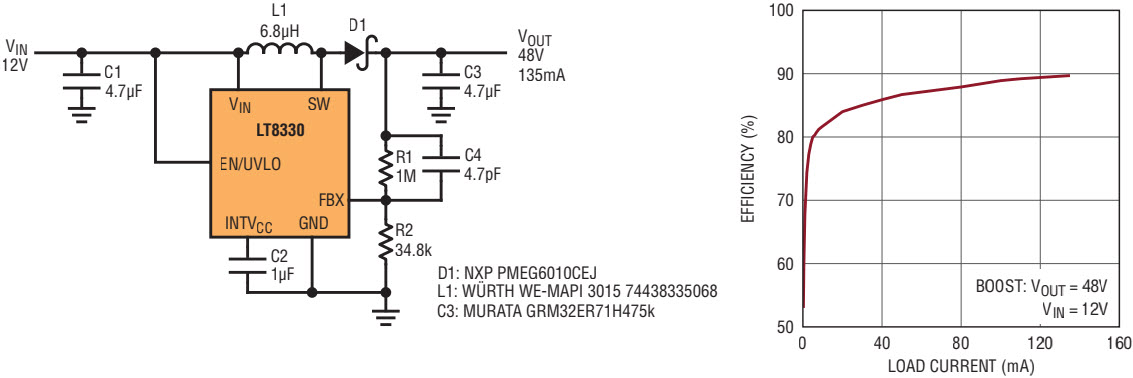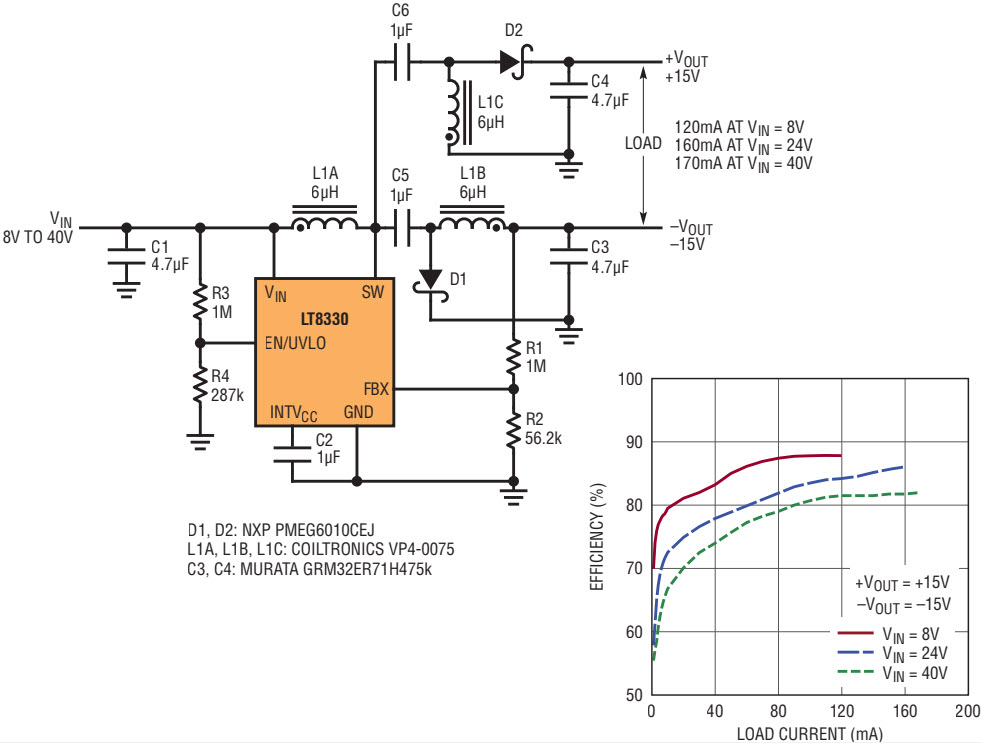Low IQ, 60V Monolithic Boost/Sepic/Inverting Converter in ThinSOT or 3mm × 2mm DFN
Low IQ, 60V Monolithic Boost/Sepic/Inverting Converter in ThinSOT or 3mm × 2mm DFN
by
Owen Jong
2016-02-01
The LT8330 monolithic DC/DC converter enables boost, SEPIC or inverting topologies in a low profile 6-lead ThinSOT™ or an 8-lead (3mm × 2mm) DFN package. It meets the demand for small, efficient power supply solutions with a 3V-to-40V input range, internal 1A, 60V switch and 6µA quiescent current. It easily satisfies the requirements of numerous industrial and automotive applications.
New Family of Space-Saving Monolithic Converters
The LT8330 is the first in a new family of monolithic boost/SEPIC/inverting converters that take advantage of new design techniques and a new process technology to achieve low output ripple Burst Mode® operation, rugged power switches and fast switching times with low AC losses. The low minimum on- and off-times of the power switch allow a wide range of duty cycles at the high 2MHz switching frequency, reducing the cost and size of the required magnetic components and capacitors.
| Part | VIN | IQ | fSW | Power Switch | Package |
| LT8330 | 3V–40V | 6μA | 2.0MHz | 1A/60V DMOS | ThinSOT–6 3mm × 2mm DFN |
| LT1615/17 | 1.1V–15V | 20μA | constant off-time | 0.3A/36V NPN | ThinSOT–5 |
| LT1613/11 | 1.1V–10V | 3mA | 1.4MHz | 0.55A/36V NPN | ThinSOT–5 |
| LT1930/31 LT1930A/31A |
2.6V–16V | 5.5mA | 1.2MHz 2.2MHz |
1A/36V NPN | ThinSOT–5 |
| LT3467 LT3467A |
2.6V–16V | 1.2mA | 1.3MHz 2.1MHz |
1.1A/40V NPN | ThinSOT–6 3mm × 2mm DFN |
| LT1935 | 2.6V–16V | 3mA | 1.2MHz | 2A/40V NPN | ThinSOT–5 |
Easy to Use
Overall converter design is simplified, and parts count is minimized by using internal compensation. Positive or negative output voltages are easily programmed using a resistor divider from the output to a single FBX pin. Integrated frequency foldback and soft-start allow the output capacitor to be charged gradually toward its final value during start-up while limiting inductor peak currents. Undervoltage lockout can be programmed for the input supply using an accurate EN/UVLO pin threshold.
Pin Compatibility
The LT8330 is pin compatible with LT3467/67A for those applications requiring higher input voltage or higher switch voltage (LT3467/67A SS pin becomes INTVCC pin).
Boost Converters
For applications requiring output voltages greater than the input, the 3V-to-40V input capability and internal 60V/1A power switch make LT8330 an attractive choice for many boost converter applications.
In some of the applications shown here, the converter is operated in discontinuous conduction mode (DCM) to achieve a very high step-up ratio. When configured in continuous conduction mode (CCM), the LT8330 is capable of delivering higher output power.
12V Input to 48V Output Boost
The converter in Figure 1 operates from a 12V input supply to generate 48V at up to 6.5W at 90% peak efficiency.

Figure 1. 12V to 48V boost converter and efficiency
8V–16V Input to 24V Output Boost
Figure 2 shows a 24V boost converter, powered from an 8V-to-16V input. It is capable of delivering up to 10.8W at an efficiency of 94%.

Figure 2. 8V–16V to 24V boost converter and efficiency
3V–6V to 48V Boost
Figure 3 shows the LT8330 configured to operate in discontinuous conduction mode (DCM) to achieve a 16:1 step up ratio. This 48V boost converter maintains an efficiency of 75% when loaded at 14mA (for a 6V input voltage).

Figure 3. 3V–6V to 48V boost converter and efficiency
SEPIC Converters
Automotive and industrial applications often operate from input voltages that are above and below the required output voltage. For applications where the DC/DC converter is required to both step-up and step-down its input, the SEPIC topology is commonly chosen. The SEPIC topology is also useful for applications that require output disconnect. This feature ensures no output voltage during shutdown and also tolerates output short-circuit faults since there is no DC path from output to input. The high 60V switch rating of the LT8330 and the low minimum on and off times of the power switch allow wide input voltage ranges even at the high 2MHz switching frequency of the LT8330.
8V–30V Input to 24V Output SEPIC
The circuit in Figure 4 shows a 24V SEPIC converter with a wide input range, delivering up to 6W at up to 86.6% efficiency.

Figure 4. 8V–30V to 24V SEPIC converter and efficiency
4V–36V Input to 12V Output SEPIC
Figure 5 shows another solution with a wide input range, with an operating input voltage that can be as low as 4V while delivering 2W of power at up to 85% efficiency. For input voltages above 24V, the circuit in Figure 5 can supply up to 3.4W.

Figure 5. 4V–36V to 12V SEPIC converter and efficiency
Cuk Converters
Negative supplies are commonly used in today’s electronics. However, many applications only have a positive input voltage from which to operate. The LT8330, when configured in the Cuk inverting topology, can regulate from a positive input voltage that is above or below the magnitude of the negative output voltage.
As with the SEPIC topology, the high 60V switch rating of the LT8330 and the low minimum on and off times of the power switch allow wide input voltage ranges even at the high 2MHz switching frequency of the LT8330.
8V–30V Input to −24V Output Cuk Converter
Figure 6 shows the LT8330 regulating a negative output voltage using the Cuk topology. This circuit delivers up to 6W of power and maintains its efficiency up to 87%.

Figure 6. 8V–30V to −24V Cuk converter and efficiency
4V–36V to −12V Cuk Converter
A −12V output CUK converter is shown in Figure 7. This circuit has a wide input range and high efficiency operation—at up to 3.4W, it achieves a peak efficiency of 86%.

Figure 7. 4V–36V to −12V Cuk converter and efficiency
8V–40V to ±15V
Figure 8 shows a dual output, +15V/−15V converter. This circuit has a wide input range and high efficiency operation—at up to 4.8W of power, it reaches a peak efficiency of 87%.

Figure 8. 8V–40V to ±15V converter and efficiency
Conclusion
The LT8330 is ideal for applications requiring efficient power supply solutions in a compact space. The LT8330’s 3V-to-40V input voltage range and 60V/1A rugged power switch enable a wide variety of boost/SEPIC/inverting converter solutions. Its low output ripple burst mode capability allows efficiency to be maintained at light loads. The low minimum on- and off-times of the power switch allow operation at 2MHz to reduce component sizing for compact power supply solutions in a tiny, low profile 6-lead ThinSOT, or an 8-lead (3mm × 2mm) DFN.




















